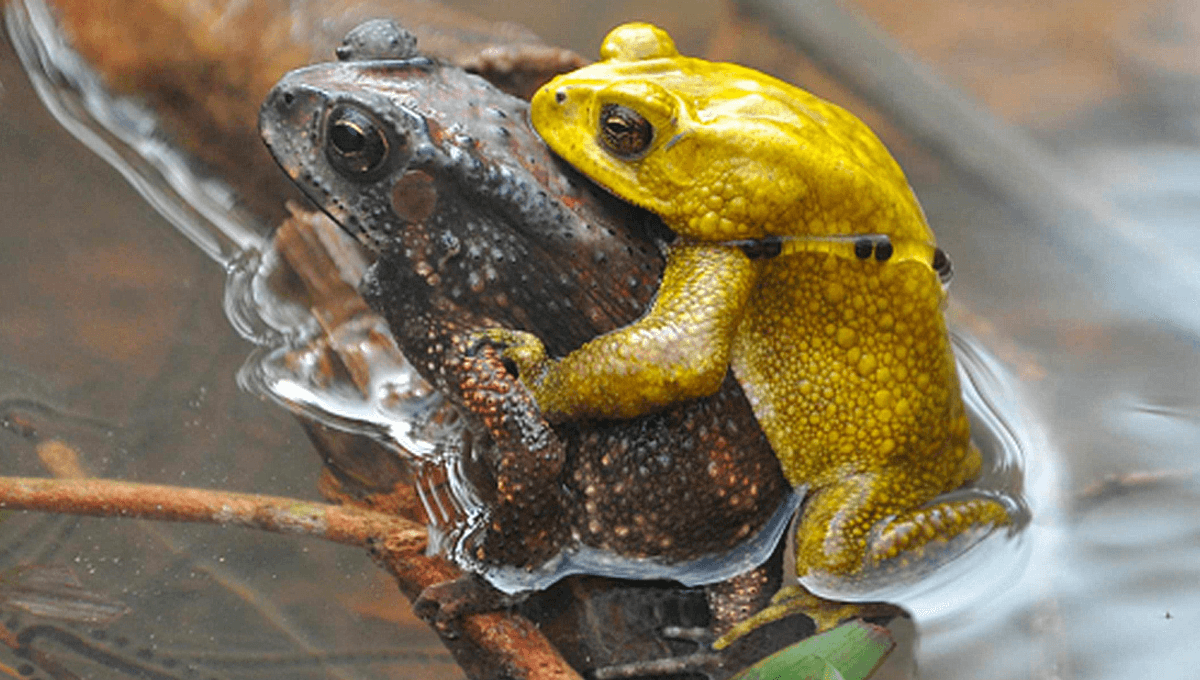-
Web sayfası bildirimcisi
- EXPLORE
-
Sayfalar
-
Blogs
-
Forums
For Just Two Days A Year, These Male Toads Turn A Jazzy Bright Yellow. Now We Know Why

For Just Two Days A Year, These Male Toads Turn A Jazzy Bright Yellow. Now We Know Why
If you’re trying to find a date, you want to look your best, right? Snazzy outfit, slick hair, makeup on point – whatever it takes to get the best choice of partner in the Grand Annual Orgy. Sound familiar? Well, it would if you were a toad.
The rest of this article is behind a paywall. Please sign in or subscribe to access the full content. “Asian Common Toads (Duttaphrynus melanostictus) [are] an explosive breeder in which males quickly turn from brown to bright yellow for up to two days during mating,” explains a recent paper aiming to answer, well, why these amphibians shun their normal coloring for neons for a short 48 hours each year. Their eventual answer? Kind of what you’d expect, honestly: “Our results show that dynamic yellow coloration displayed by males can be easily discriminated against brown female conspecifics from a toad's point of view,” the authors write. It may make sense intuitively, but that doesn’t mean it didn’t need proving – so to do so, the team took a two-pronged approach. First, they became the toad: using a computer model and spectrometer data about the animals’ colorings, they developed a kind of toad-vision simulator that allowed them to see the world through the amphibians’ eyes. “We suggest that dynamic sexual dichromatism in the Asian Common Toad has evolved as a visual signal that mediates swift mate recognition in time-limited, dense breeding groups,” the authors write, adding that “dynamic sexual dichromatism acts as a visual signal to enable quick mate recognition in a way that likely reduces costly male–male mismatches.” That’s lucky, really – because when toads get horny, they don’t have time for little things like “making sure whoever is under you is actually a female”. In fact, they barely have time for making sure it’s actually a toad, or even any kind of living thing at all: “Males amplect [mount] everything that is brown,” Doris Preininger, a researcher and herpetologist at the Vienna Zoo and co-author of the new paper, told Mongabay. “Even a beetle nut.” And when the team created two model toads, one brown and one bright yellow, and set them down in the vicinity of some lusty toads, the proof was evident. “During model experiments, males had twice as much physical contact with brown models and clasped them 40 times more often than yellow models,” the paper reports. But interestingly, what the yellow color doesn’t signify is any kind of fitness for breeding. To put it bluntly, the females don’t get much choice in the whole toad mating shindig – so there’s no real need for male toads to advertise how strong or healthy they are. “We compared size, weight, and body condition,” the researchers told Mongabay. “Yellow males weren’t necessarily stronger or bigger.” “The color just tells you it’s a male – nothing more, nothing less,” they said. “But how these hormones maintain that yellow hue for a day or two is something we still don’t fully understand.” In other words, if you’re a male toad, temporarily turning bright yellow is just an easy way to make sure other males don’t try to mate with you. Equally, if all your comrades are also sporting a neon hue, it makes them easier to avoid in your frantic urge to mate with anything even vaguely resembling a female toad – but, honestly, this seems less important than avoiding their advances on you. For females, the whole thing sounds terrible: males will “fight, kick, and try to displace other males” who are already mounted on a female, Vienna Zoo herpetologist and researcher Susanne Stückler told National Geographic. Once they get free and lay eggs, the female toads – understandably, really – dip as quickly as possible. They leave the mating area, trying to hide in holes from the hoards of males literally chasing them on the way out. “Sometimes, several males try to [simultaneously mate with] the same female, forming ‘mating balls’,” said Stückler, who is also corresponding author of the paper. “[That] can even lead to [the] female drowning.” The good news for the females? At least this whole thing only lasts two days. “A day after the event you can only see the egg strings in the water,” the researchers told Mongabay. “About one week later, the tadpoles will hatch and disperse.” Just in time for next year’s orgy. The paper is published in the journal Ichthyology & Herpetology.


